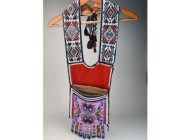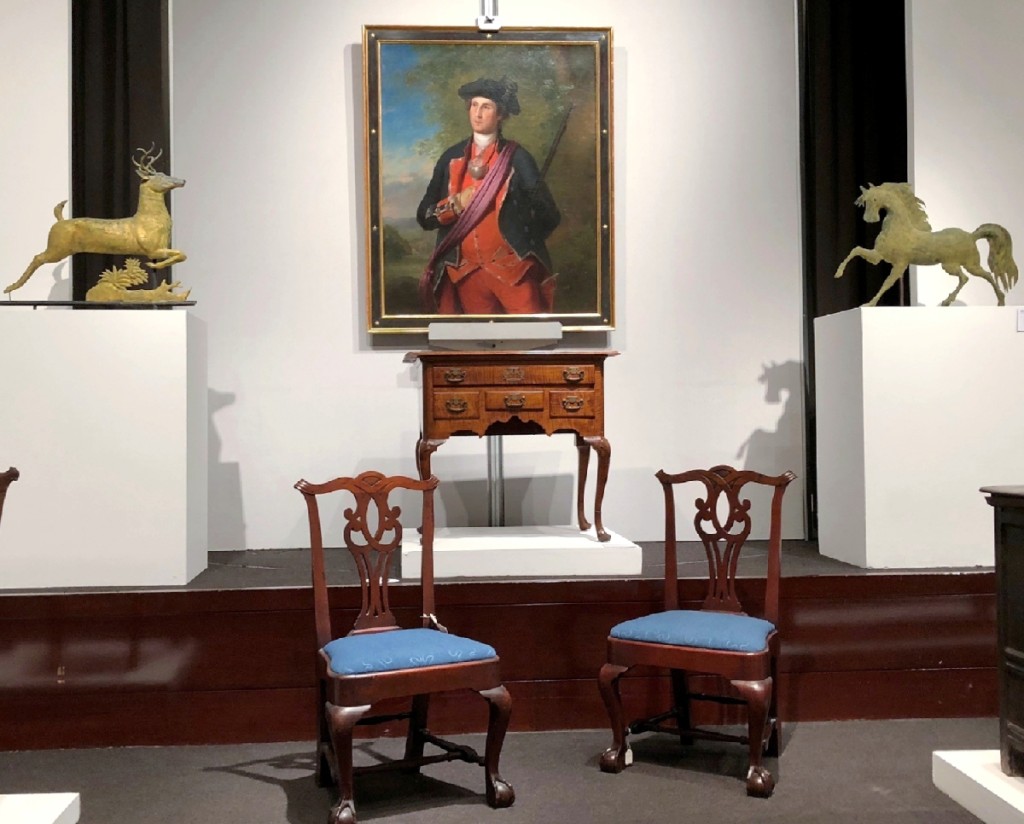
The magnificent portrait of George Washington as an Alexandria Militia colonel occupied Christie’s center stage. Rembrandt Peale’s painting of the young officer sold for $852,500 ($400/600,000) to Maryland dealer Stiles T. Colwill, underbid by Virginia dealer Taylor Thistlethwaite. Below it, the Queen Anne Philadelphia figured maple dressing table found no buyer at $240,000. Massachusetts dealer Gary Sullivan underbid the pair of Newport side chairs attributed to John Townsend that went to the phone for $150,000 ($30/50,000). Attributed to J.W. Fiske & Company, the circa 1875 stag weathervane made $27,500 ($8/12,000). The horse weathervane, probably by A.L. Jewell & Co., circa 1860, hit $6,250 ($5/10,000).
Review and Onsite Photos by Laura Beach
NEW YORK CITY – Christie’s kept it breezy on January 19 and 20, generating sales of $8,255,750 on fewer than 600 lots. The Rockefeller Plaza firm kicked of Americana Week with sessions of Chinese Export Art, $2.1 million and 85 percent sold by lot; continued with Outsider and Vernacular Art, $2 million and 96 percent sold; and concluded with Important American Furniture, Folk Art and Silver, $4.1 million and 81 percent sold.
In 2010, MSNBC “Morning Joe” co-host Mika Brzezinski caused a stir when she seemed to suggest that Lincoln was her favorite Founding Father. Among presidents more reliably included in this group, Washington heads the list. At Christie’s, it was Washington who commanded the audience when a portrait of the youthful military man crossed the block at $852,500. Reliably attributed to Rembrandt Peale (1778-1860), the picture went to Maryland dealer, designer and former museum director Stiles T. Colwill, underbid by Taylor Thistlethwaite, a dealer with premises in Virginia and Kentucky. The Peale family is much in the news of late, what with Carol Eaton Soltis’s new book The Art of the Peales in the Philadelphia Museum of Art, published by Yale University Press in December 2017, and a symposium planned at the museum on Friday and Saturday, February 16 and 17.
The portrait, which shows the dashing young soldier during the French and Indian War, dates to the early Nineteenth Century. The original painting by Rembrandt’s father Charles Willson Peale (1741-1827) dates to 1772 and is part of the Washington-Custis-Lee collection at Washington and Lee University in Lexington, Va., where Colwill and Thistlethwaite both recalled seeing it. Intriguingly, the Rembrandt Peale work came up at Skinner in 2004, where it sold for $446,000 against an estimate of $12/18,000.
“It is going to a private collection, to a family of collectors who have been known to lend things publicly, so we may see it in the future,” Colwill, reached in London, where he was attending the Decorative Antiques & Textiles Fair, told us after the auction. He added, “I’ve been a student of the Peales going way back to my days as curator and director of the Maryland Historical Society. I was aware of this painting when it came up at Skinner. This time, it had been expertly conserved and was accompanied by a lengthy report from Eaton Soltis.”
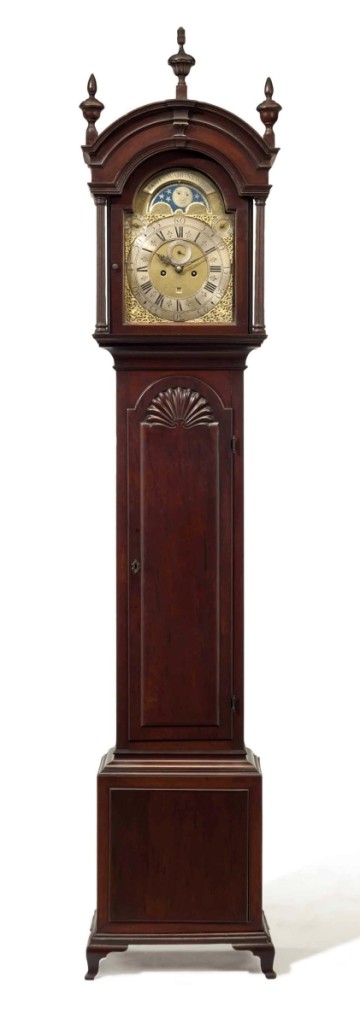
“It’s a premium clock by a supremely important maker, and it has survived intact in great condition,” Gary Sullivan said of this Newport, R.I., block and shell tall case clock with works by James Wady (d 1759). The Massachusetts dealer bought the Hunter-Dunn family timepiece of 1750–59 for $612,500 ($ 00,000). Christie’s last auctioned the clock for $442,500 in 2000.
Colwill continued, “As the early Peale scholar Charles Coleman Sellers (1903-1980) said, Charles Willson Peale knew the founders and painted them when they were young and full of spit and vinegar. Gilbert Stuart painted them when they were old, gray and full of honor. This shows the youthful George Washington, the sword he had his whole life at his side, in all his youth and glory. For me it was a once in a lifetime opportunity, and I pitched it to my clients, who agreed. I was surprised at the price. We were prepared to go well beyond that and were delighted to win it.”
Taylor Thistlethwaite said, “For me it is a monumental portrait of Washington and the best thing about it is that it represents him at the beginning of his career. You always see Washington as the president or as a general. This is Washington as a Virginian, dressed in his Alexandria militia uniform, carrying a rifle. So, he is not elevated to the god-like figure that he was later on. You will find 20 other images of Washington, but this one is special. I honestly thought it was inexpensive and that it might have gone into the millions. This, in my mind, was a masterpiece.”
Conventional wisdom discourages return appearances for works of art at auction. However, like Rembrandt Peale’s Washington, several top furniture lots at Christie’s were repeats. Leading the group was the block-and-shell carved Hunter-Dunn family Newport Chippendale mahogany tall case clock of 1750-59 with works by James Wady (d 1759). It sold to Gary Sullivan, an authority on early American clocks, for $612,500 ($200/300,000).
“Wady is one of the top three makers of early American clocks. This one is in amazing condition and has wonderful historic surface and great color,” the Massachusetts dealer told us. Sullivan said he was sad to lose a pair of Newport Chippendale mahogany side chairs attributed to John Townsend that went to a phone bidder for $150,000 ($30/50,000).
Possessing extraordinary charm, a sampler worked by Mary Russell in 1791 tripled its high estimate to bring $324,500, notwithstanding obvious losses to its black silk ground. Philadelphia dealer Amy Finkel, who watched in the room as competing phone bidders battled it out, said, “I’m happy for it. It’s an iconic piece with some isolated condition issues.” According to Christie’s, Russell’s needlework, one of five similar pieces known, may be from Bristol, R.I., or Marblehead, Mass.
-1024x301.jpg)
From the collection of Marjorie and Harvey Freed, this double-sided mixed-media work on paper by Henry Darger (1892–1973) topped Christie’s cataloged session of Outsider and vernacular art, selling for $672,500 ($200/400,000).
Outsider & Vernacular Art
“It was Christie’s best sale of Outsider and vernacular art so far, our largest and highest total. We had a deep roster of interested parties for almost all the works. One thing we really focused on was providing a range of pieces, some accessible to new collectors and others A-plus-plus works for blue-chip buyers who are already involved in the field. It is important to us that everyone can participate. Our audience included collectors, curators, critics and artists. A full community of folks who love this material came out and supported the field,” Christie’s specialist Cara Zimmerman told us.
The session got a boost from 52 stellar lots consigned by Chicagoans Marjorie and Harvey Freed, vanguard collectors who were founders of Intuit: The Center for Intuitive and Outsider Art in that city. The Freeds bought directly from artists and through such leading dealers as Phyllis Kind, Carl Hammer and Russell Bowman. Marjorie writes that she was initially drawn to traditional American folk art. The couple’s first piece of Outsider art was a wooden sculpture by Chicago artist William Dawson.
Leading the Freed slew was a double-sided, 81-inch-long mixed-media on paper composition by Henry Darger (1892-1973) on his signature theme, the Vivian Girls. Easily exceeding high estimate, it sold to a seated couple in the room for $672,500. It is the second most costly Darger listed in the online auction prices database Askart.com.
There were five compositions on paper by Bill Traylor (1854-1949) in the “white-glove” Freed sale. The best of the group, “Drinking Man With Dog” of 1939, went to collector Jerry Lauren for $137,500, nearly tripling its high estimate. Lauren told us he owns 20 Traylors, including one worth a million dollars. He loved this one for its graphic excellence, dark brown pigment and the artist’s genius use of negative space.
Pieces by Aloïse Corbaz and Adolf Wölfli led a small selection of European Art Brut. From the Namits collection, “Aristoloches,” a double-sided colored drawing, circa 1925-33, by Corbaz, went to an online bidder from Luxembourg for $137,500. An untitled colored pencil and graphite drawing on paper by Wölfli, also Namits property, made $75,000.
Zimmerman concluded, “This field has been exciting since its inception in Europe in the 1920s. It has gotten to a very interesting point now where people in different fields are embracing it as part of a larger constellation of expression and aesthetics. Ruptures lead to new ways of seeing. We are seeing an interjection of Outsider voices into a narrative that hasn’t included them until today.”
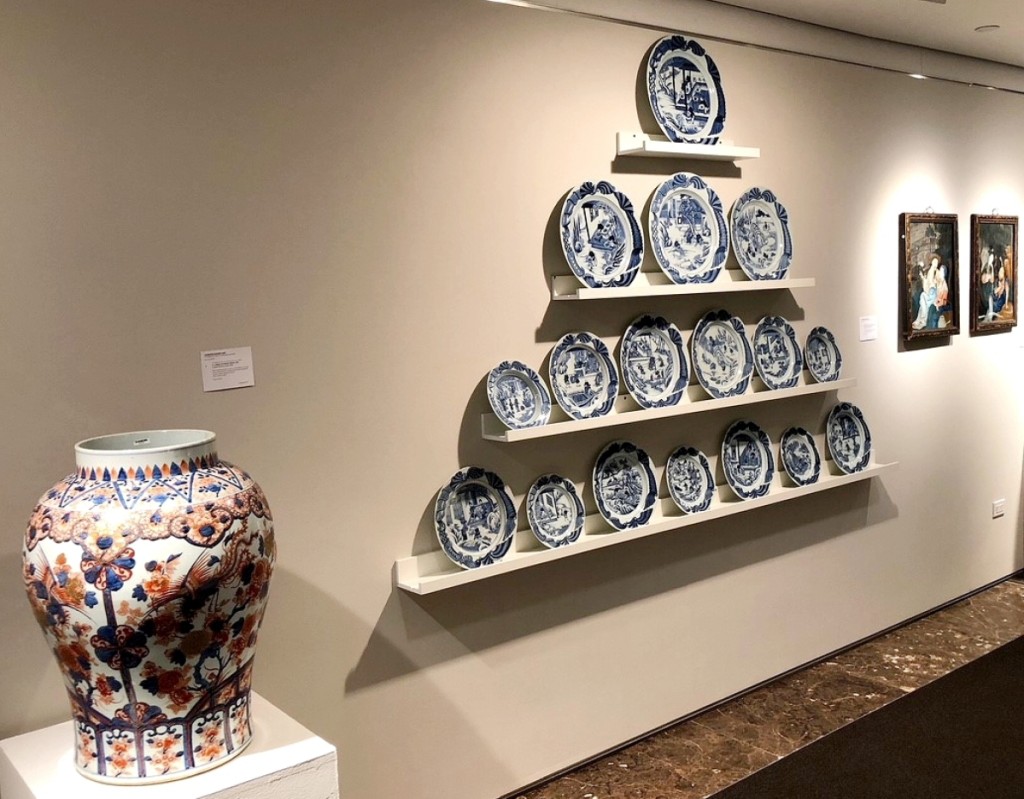
Christie’s cataloged sale of Chinese export art was topped by a set of blue and white Qianlong period dishes depicting tea cultivation, $150,000 ($40/60,000). Left, the Kangxi period Imari jar fetched $17,500 ($7/10,000). From Marchant, the Qianlong period reverse paintings on glass, far right, depicting courting Chinese couples earned $21,250 ($6/9,000).
Chinese Export Porcelain
Several distinguished provenances were listed in the catalog accompanying Christie’s January 18 sale of Chinese export art. One was London antiquary Marchant. Founded in 1925 by Samuel Sidney Marchant, the Chinese art firm took a direct hit during the Blitz but recovered sufficiently to reopen on Duke Street before moving to their present location on Kensington Church Street. Richard Marchant served as chairman of the British Antiques Dealers Association between 2005 and 2009.
The roughly 100 lots consigned by Marchant included a large verte Imari monteith, $87,500, circa 1740, and an Eighteenth Century famille rose punch bowl, $56,250. Leading the session overall was an extraordinary set of blue and white Qianlong period dishes depicting tea cultivation. From a notable Southern collection, the set, probably made for a Dutch tea merchant, brought $150,000.
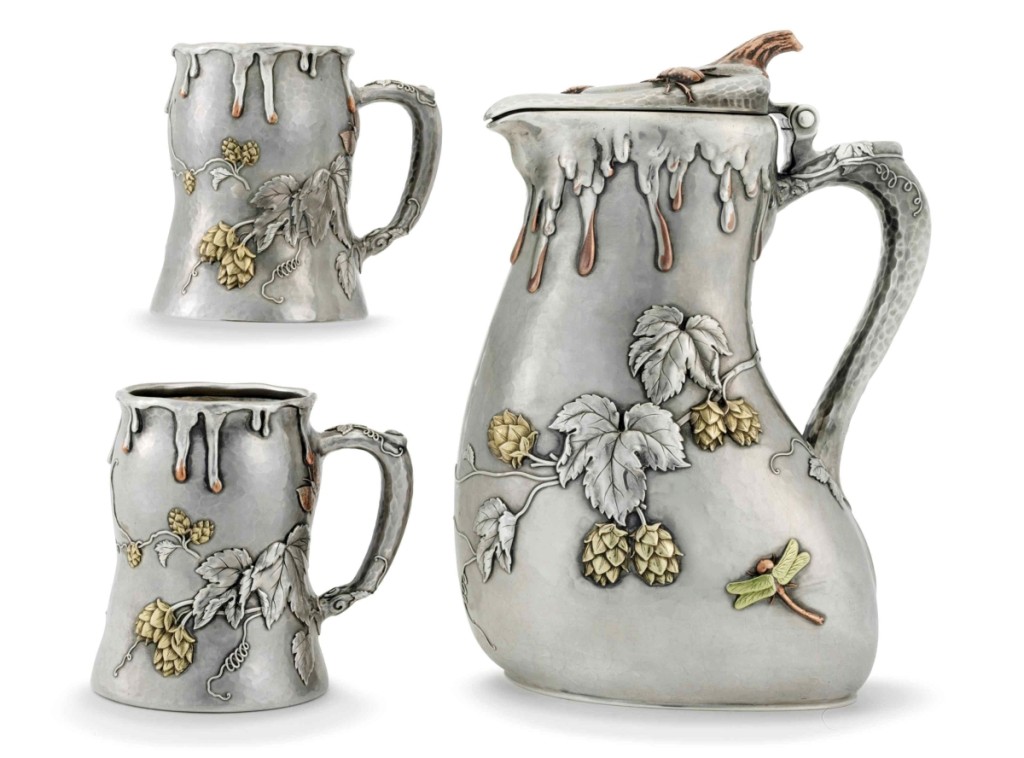
This japanesque mixed-metal ale drinking set, $112,500 ($50/70,000), is by Tiffany & Co. French marks suggest it may have been shown by the firm at the 1878 Paris Exposition.
Silver
Christie’s saved silver for the last. The nearly 70 lots offered on January 19 included a smattering of Eighteenth Century pieces, some interesting regional examples, sought-after works by Tiffany and Gorham, and a signature group of ten objects associated with Dwight and Mamie Eisenhower. Among the latter, a circa 1940 Tiffany & Co. silver flatware service in the Century pattern sailed past its $12/18,000 estimate to bring $60,000. The service is monogramed with the initials DDE for President Dwight D. Eisenhower and was used aboard the precursor to Air Force One.
Tiffany & Co. mixed-metal pieces from other sources included an unusual three-piece ale drinking set in the japanesque style, $112,500. The pitcher and two mugs, circa 1878, may have been shown at the 1878 Paris Exposition.
Prices include buyer’s premium. For information, 212-636-2000 or www.christies.com.















.jpg)



